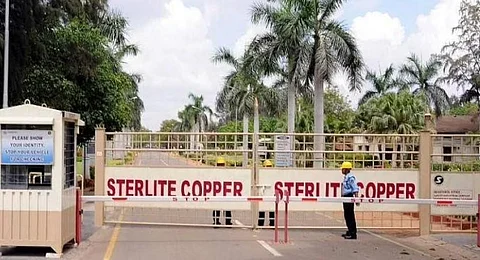

THOOTHUKUDI: Three months after the evacuation of gypsum from the Sterlite Copper plant premises was temporarily suspended after it was found that the mineral quantity greatly exceeded estimates, a top official from the Tamil Nadu Pollution Control Board (TNPCB) has said the evacuation process will resume following a high-level meeting on the issue.
Following the closure of the copper smelter plant on May 28, 2018, a high-power committee that inspected the premises, recommended the safe removal of hazardous materials like acid, fuel, raw materials, and solid wastes from the plant site. The panel estimated that 5,100 KL (kilo litres) of sulphuric acid, 3,100 KL of Phosphoric acid, 49 KL of liquid petroleum gas, 255 tonnes of liquid oxygen, 8 tonnes of liquid nitrogen, 826 KL of high-speed diesel/oil, 150 KL of hydrofluorosilicic acid, 8 KL of isopropyl alcohol, 90,000 tonnes of copper concentrate, 4.5 lakh tonnes of gypsum and 63,300 tonnes of rock phosphate, had to be removed in a time-bound manner under the close supervision of a local level committee.
Large quantities of chemicals, except copper concentrate, were removed before August 10, 2018. Later, the State government accorded permission for 250 persons, including contractual employees, to engage in the removal of the remaining hazardous chemicals and materials from the smelter premises. Accordingly, the high-power committee set a 60-day timeline each for treating gypsum pond leachate, removing copper concentrate, removing of gypsum (4.5 lakh tonnes), and removal of residual acid present in the tanks (1,210 tonnes).
Thereafter, an inspection by the members of the Local Monitoring Committee on April 13 this year revealed that the removal of copper concentrate and rock phosphate was completed. Whereas, treatment of secured landfill leachate and gypsum pond leachate hit a roadblock as they could not operate the Effluent Treatment Plant (ETP) using Mobile DG sets. Moreover, non-pumpable portions of heavy furnace oil, light diesel oil, sulphuric acid stock and phosphoric acid have still not been removed.
Similarly, the committee found that the Sterlite authorities had removed over 12,32,999 tonnes of gypsum as of April 12, against the panel's estimate of only 4.5 lakh tonnes of gypsum present at the site, and the evacuation was still underway two and a half years after the timeline expired. The monitoring committee subsequently assessed the plant again and found that approximately 1.28 lakh tonnes of gypsum still remained on the plant premises.
Subsequently, the district administration stopped the evacuation process and prevented the entry of vehicles into the plant through an order dated April 25. Sources said the plant had requested permission for operating a fixed furnace oil-based captive power plant for using the Effluent Treatment Plant and RO to treat secured landfill leachate and gypsum pond leachate, alongside an extension of the timeline for removing gypsum remains.
When contacted, a top official from the TNPCB, who is also a member of the high-power committee, told TNIE that the gypsum quantity was much above the estimated amount. "The authorities have sought permission to remove the remaining 1.28 lakh tonnes of gypsum. We will discuss that in an upcoming meeting and take appropriate action," he said.